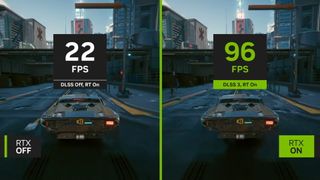Nvidia's frame generation works with AMD FSR and Intel XeSS
It's a scaling tech mix 'n match free for all. For now.

Fancy a spot of AMD-powered FSR super scaling with a garnish of Nvidia's latest frame generation technology? Well, it turns out that can actually be done. For now.
It's possible for two reasons. Firstly, Nvidia's new frame generation feature within its broader DLSS 3.0 resolution and performance scaling platform can be enabled as a stand alone feature. Secondly, Nvidia's competition in the resolution scaling market—namely AMD and Intel—have both seen fit to allow at least some iterations of their own super scaling technologies to run on competitor GPUs.
Of course, that doesn't work the other way round. Nvidia's DLSS only runs on Nvidia GPUs and indeed Nvidia frame generation tech only works on its very latest RTX 40-series graphics cards, such as the RTX 4090. Currently, neither AMD nor Intel offer a similar frame generation tech to Nvidia's. AMD's is promised for 2023. But even if they did, you wouldn't be able to run AMD frame generation plus Nvidia DLSS on, say, an AMD GPU.
As it is, a few intriguing questions emerge: For how much longer will this situation last? Could mixing and matching of various super scaling and frame generating technologies become the norm? And if so, will it always make more sense to stick with the hardware vendors software for a given GPU, or could you actually get better results another way? Imagine if Nvidia graphics actually looked better and ran faster with AMD FSR and a frame generation solution from Intel.
A graphical trifecta.

If that's highly speculative, for now it is actually possible to compare the performance of the new RTX 4090 GPU running Nvidia's frame generation tech alongside its own DLSS scaling and then for comparison AMD FSR and indeed Intel XeSS. Happily, Igor's Lab has done just that.
Their conclusion? Nvidia's frame generation tech works just fine with both FSR and XeSS. What's more, the performance difference between FSR and DLSS in that context is minimal, with XeSS lagging very slightly behind. However, if you look in detail at the results, which are based on Spider-Man Remastered, you will find that it's AMD's FSR that gives the outright fastest frame rates.
The biggest gaming news, reviews and hardware deals
Keep up to date with the most important stories and the best deals, as picked by the PC Gamer team.
Once we're not drowning in Black Friday PC gaming deals hubs, perhaps we'll get around to testing it ourselves. For now it at least looks like, if you want maximum frame rates from your RTX 4090, a mix of Nvidia and AMD scaling technology will do the trick. The truth is a bit more complicated than that. Using the highest quality scaling setting, it's DLSS that's slightly faster, for instance.
You've also got the painfully nuanced question of image quality when comparing competing scaling technologies. Moreover, support for this kind of mix 'n match is inevitably going to vary by game. You can't just assume it'll be available on every title.
And don't forget about latency. Might there would be a latency cost of mixing Nvidia frame generation with some else's super scaling? In other words, as if all this scaling tech stuff wasn't already complicated enough, the whole thing just got a lot more bamboozling. But as hard as it is to keep up with this fast developing sub-genre of graphics performance, there's no denying the end results are likely to benefit us all: better looking games and faster frame rates on Nvidia cards? Yes please.

Jeremy has been writing about technology and PCs since the 90nm Netburst era (Google it!) and enjoys nothing more than a serious dissertation on the finer points of monitor input lag and overshoot followed by a forensic examination of advanced lithography. Or maybe he just likes machines that go “ping!” He also has a thing for tennis and cars.
Most Popular





